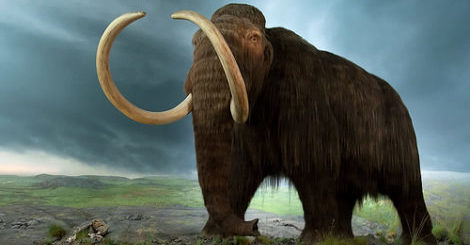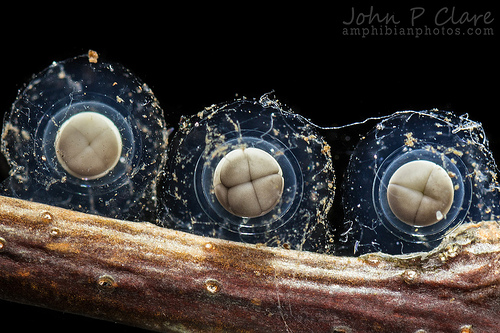
 )
)Earlier this month, we looked at some man-made extensions to the bacterial genetic code. If that story got you worried about Dr. Frankenstein, you’re going to love last week’s announcement. Harvard biologists believe that within two years they will be able to create a woolly mammoth-African elephant hybrid embryo. Bringing back the mammoth is part of a larger program of “de-extinction” to explore the possibility of bringing back various extinct species, at least some of which we humans are responsible for eliminating. We broke it; now we have to fix it.
Now, before the Jurassic Park fans get too excited, let’s get a few things straight. Perhaps thanks to the Flintstones, you might think that woolly mammoths and dinosaurs were contemporaries. In reality, dinosaurs went extinct 65 million years ago. Woolly mammoths didn’t show up until a few hundred thousand years ago and co-existed with humans. There are cave paintings of mammoths; humans hunted them, possibly to extinction. Some isolated populations may have persisted until as recently as 4,000 years ago, within the scope of recorded history. All of that to say, any success with this de-extinction project won’t necessarily translate to Triceratops or Stegosaurus. Sixty-four million years is a huge difference in terms of DNA preservation and the options for obtaining a complete genome.
Furthermore, if this project is successful, the end result will still be more elephant than mammoth. They are not directly cloning a woolly mammoth the way we cloned Dolly the sheep. They are editing the genome of Asian elephant cells to give them some mammoth genes. In fact, they have already done so; the next steps are to increase the number of genes and then transfer the nucleus into an elephant egg cell as with other cloning experiments. Exactly what that will produce is difficult to say; finding out is one potential justification for doing the experiment in the first place. There will likely be a case to make for designating it as a separate species from both mammoths and elephants. We’ll probably never see a mammoth exactly like the ones our ancestors drew.
Finally, if everything goes as projected, in two years what they will have is an embryo. There will still be more steps to work out and more time required for that embryo to gestate into a fully developed, well, whatever it will be. And that’s assuming the scientists choose to continue at that point, given the technical challenges and ethical concerns. Among those concerns are questions about what the quality of life would be for the resulting animal, given the number of unknowns about the anatomy and physiology. Perhaps some of those questions will be resolved in the next couple of years and this group or another will go forward. But until that point, let’s just say no one will be opening a theme park for people to look at embryos.

 )
)But let’s assume it all works and a few years from now something resembling a woolly mammoth is walking the earth again. We still won’t be restoring an extinct population. A robust species requires some amount of genetic diversity beyond what one or a few individuals can provide. Further genome editing could potentially provide some variation, but we don’t necessarily know what variants would be most helpful. With a large enough population, that wouldn’t matter as much, but it’s hard to imagine anyone footing the bill to make a few thousand genetically engineered mammoths. Actually, it sounds like if anything they are hoping this is a way to introduce diversity into the Asian elephant population, which is itself endangered.
For that matter, it’s not clear it would be a net positive to bring back mammoths or any other extinct animal, even if we could wave a magic wand and solve all of these problems. Their habitat won’t necessarily be the same. Whatever plants or animals they ate won’t necessarily be the same. Whatever bacteria and other organisms made up their microflora won’t be the same. They might be especially susceptible to modern diseases. They might become an invasive species and significantly disrupt whatever ecosystems they occupy. The story mentions the possibility of mammoths preventing permafrost melting by breaking through the snow that insulates the ground from the cold air, but it’s hard to imagine we’ll actually have enough mammoths to make a sustainable difference. Are there no other options for achieving a purely mechanical result of holes in snow which are less problematic?
It’s also worth noting that most extinct species are not cuddly or awe-inspiring animals. To a first approximation, the present day animal kingdom is basically ants and nematode worms; they likely make up a bulk of extinct animals as well. Bacteria and phages, the viruses that infect bacteria, are even more numerous and diverse. Then there are plants and fungi, not to mention the protists that even as a biologist I have to make an effort to remember. So bringing back a few famous species like woolly mammoths, passenger pigeons, dodos or Tasmanian tigers would be negligible in terms of biodiversity.
The most likely scientific value from woolly mammoth de-extinction would probably be a deeper understanding of the genetics of embryogenesis and development. Replacing genes from one species with variations from another is one way to learn what those genes do and what the significance is of the differences between species. Mammals share many developmental genes, so we might even learn something applicable to human development. That knowledge might help treat human diseases or even suggest a way to prevent them. I’m not sure that’s likely or justifies the project, but it is probably the best case scenario.
I suppose there is also some symbolic value to bring back a species we likely helped to drive to extinction. However guilty we may feel, it probably isn’t a good idea to bring back large numbers of such species. But the mammoth might inspire us to make more of an effort to protect species that are still with us currently. And thus we have a sort of tragedy of the biological commons. For any individual organism, it is likely suboptimal to be brought into the world via speculative engineering processes. But the overall health of the ecosystem may benefit from the inspiration provided by a few such individuals.
Andy has worn many hats in his life. He knows this is a dreadfully clichéd notion, but since it is also literally true he uses it anyway. Among his current metaphorical hats: husband of one wife, father of two teenagers, reader of science fiction and science fact, enthusiast of contemporary symphonic music, and chief science officer. Previous metaphorical hats include: comp bio postdoc, molecular biology grad student, InterVarsity chapter president (that one came with a literal hat), music store clerk, house painter, and mosquito trapper. Among his more unique literal hats: British bobby, captain’s hats (of varying levels of authenticity) of several specific vessels, a deerstalker from 221B Baker St, and a railroad engineer’s cap. His monthly Science in Review is drawn from his weekly Science Corner posts — Wednesdays, 8am (Eastern) on the Emerging Scholars Network Blog. His book Faith across the Multiverse is available from Hendrickson.

Leave a Reply